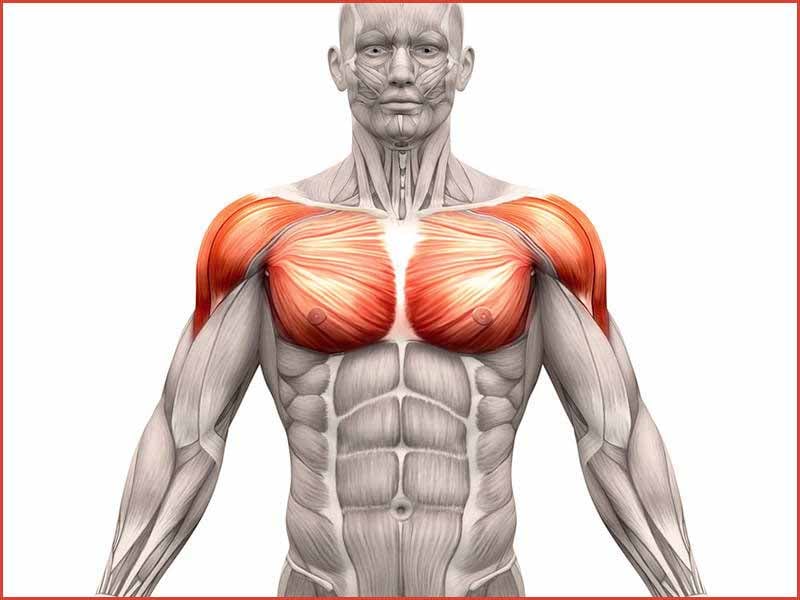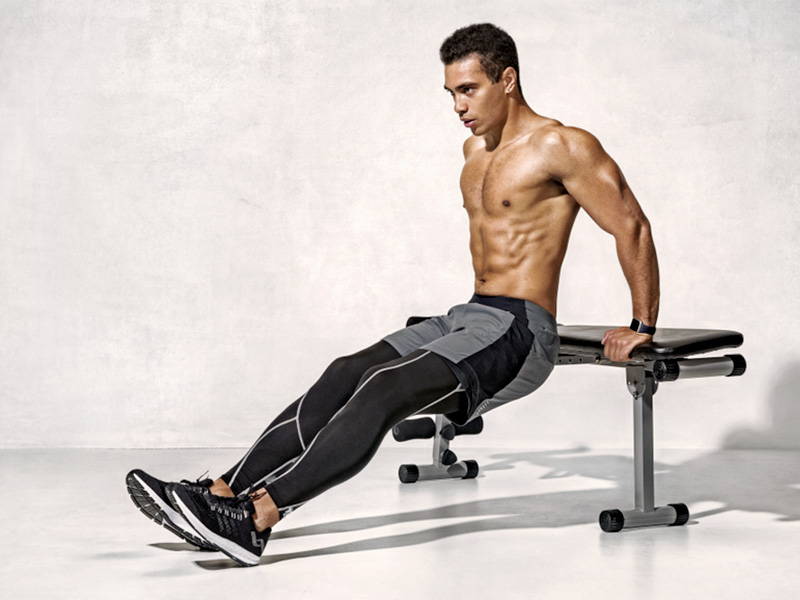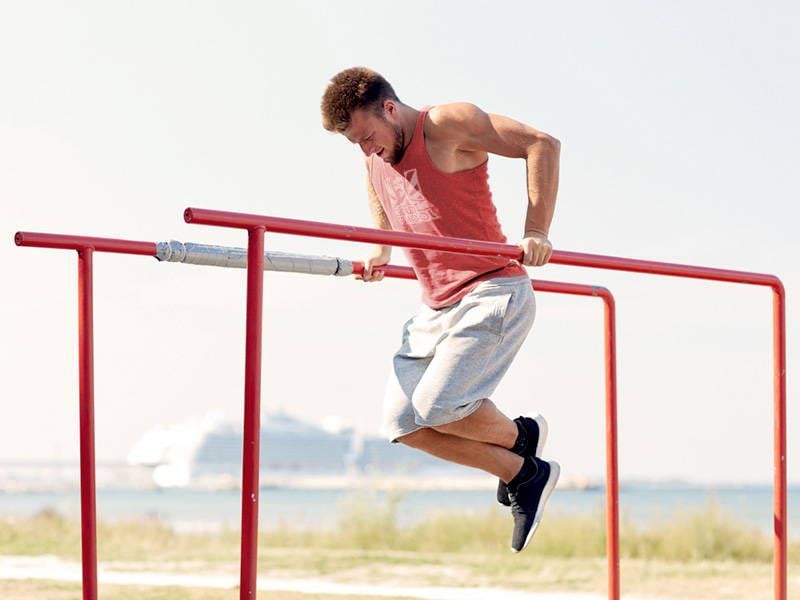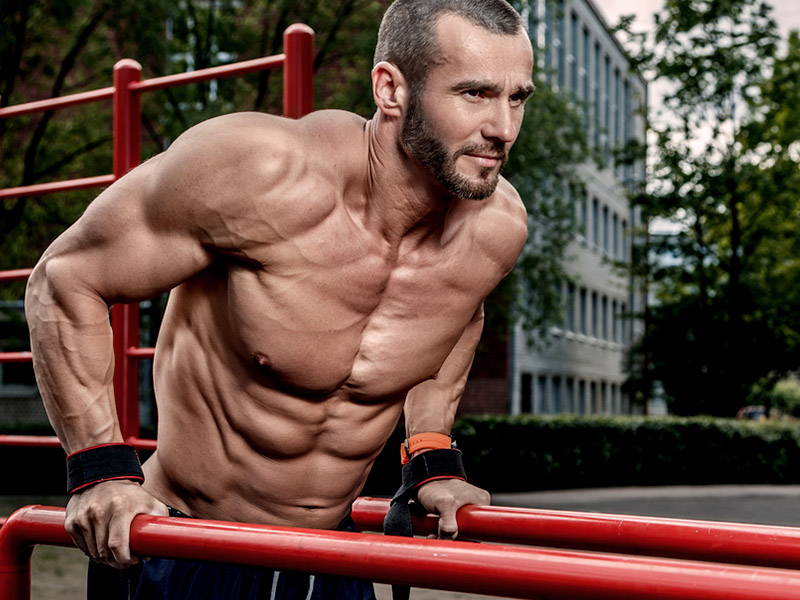
Dips: Best Exercises & Workouts
Key Takeaways
- Dips are an effective bodyweight triceps and chest exercise. They are not for beginners who lack upper body strength.
- Doing dips can help build grip strength, bust plateaus, and build serious muscle mass.
- They can be done at the gym or at home, with some basic equipment. Dips are traditionally done using a machine, parallel bars or rings. But you can also do them at home using weight benches or chairs.
- Proper form is crucial when performing dips, as the likelihood of shoulder injuries is high. Dips are not the best exercise for someone with pre-existing shoulder issues.
Dips can be an underutilized exercise in the gym or at home. This exercise is for intermediate or advanced lifters who have some upper body strength.
They can provide benefits that other exercises do not. Today, we discuss the benefits of dips, as well as:
- Muscles worked
- Ways to do them at home and at the gym
- How to do them for the first time
- Common mistakes and how to avoid them
Dips Muscles Worked
When doing your dips workout, what muscles are being worked? Primarily, the triceps are working.

The anterior, or front, of the shoulder muscles are worked, rather than the posterior. The pectoralis major in the chest will also be targeted when including dips in your workout. Finally, the rhomboid muscles in the upper back also help complete the exercise.
The following muscles act as synergists:
- Deltoids
- Upper back
- Chest
The traps, abs, and biceps are worked to a lesser degree as stabilizer muscles. Yes, we said abs. As you move through the exercise, your core must be tight and engaged to keep your body steady.
When completing chest dips, the pectoralis major takes front stage, with the rest as synergists. The traps help to stabilize the movement.
Now, let’s talk about the benefits of doing them.
Dips Exercise Benefits
There are a few reasons that dips exercises should be included in your workout routine.
Increased Weight Capacity
When doing dips, you’ll want to start with bodyweight only. Soon enough, you’ll be ready to increase the challenge.

The best way to do this is to add weights. You can do add weights several different ways:
- Using a weighted belt
- Holding a dumbbell between your legs
- Wearing a weighted backpack
The amount of weight you can add is almost limitless (based on your own restrictions). You don’t have to worry about maxing out on a machine or reaching the limit of weight plates.
Build Muscle Mass
By increasing the weight over time, you are proving a progressive overload to your muscles. Combining dips with other upper body exercises will practically guarantee an increase in muscle mass.

Variations of dips (more on this later) can also target muscles differently. Focused on the chest? Then be sure to add in the chest dip.
Need to work your triceps? The triceps dip will help target those muscles.
Better Lockout Strength
If you are someone who struggles with the lockout in the overhead press or bench press, dips can help.

To finish the dip, you must reach lockout. You may not see results at first, but as your dips improve, you should notice a difference. Once a plateau problem, you can now reach lockout with renewed confidence where you struggled before.
A Unique Exercise
Dips are one of the few closed kinetic chain exercises (pull ups and push ups are too).
What’s a closed kinetic chain (CKC) exercise? It’s where your hands or feet remain stationary while your body moves through the exercise.
A CKC exercise works opposing muscle groups during the lifting and lowering phases of the exercise.
Dips Exercises at the Gym and at Home
If you’ve done them before, you may have used one of the dips machines at the gym. There is a seated version and an assisted dip machine where you rest your knees on a platform.
These versions are okay, but they remove the stabilizing muscles from the equation. They may be easier, but you won’t be using the muscles as they’re meant to be used for dips.

If you’re working out at the gym, there are better ways. You could use:
- Parallel bars
- Rings
- Two weight benches (set up like parallel bars)
If you’re working out at home, you also have some flexibility. You can use a weight bench or even a couch or chair to do dips.
Be warned though, using a single object can cause shoulder impingement. When placing your arms behind you with your elbows out, the shoulders are very vulnerable. The maximal internal rotation could cause a shoulder injury, even when doing a bodyweight dip.
The best course of action is to use two stationary objects placed parallel, similar to parallel bars. This could be two benches or chairs, or even a countertop, if you’re at home working doing your dips.
Are Dips Right for Everyone?
As you may have suspected, dips are not right for everyone. If you’ve had a prior shoulder injury, they may not be for you. It’s best to talk with your doctor to find out if this is a safe exercise for you to try.
If you feel any pain or discomfort in your shoulder when performing the exercise, stop immediately. Your form could be off or there could be something going on with your shoulder.
Talk with your doctor before trying again for anything other than normal muscle soreness.
Doing Dips for the First Time
Are you ready to incorporate dips into your workout routine? Be sure you use proper form and start out with bodyweight only before you progress into variations.

Here you can find form instructions for both triceps and closed grip versions. Tricep dips work all three heads of the tricep muscle while closed grip dips focus on the lateral head.
You can find details here on form for a chest dip. The only difference between the chest dip and triceps dip is you’ll bend forward at the waist doing chest dips.
Need a visual for these exercises? Here are a few to check out:
Obviously, you can sub chairs for benches if you’re working out at home.
But what if you aren’t able to do a dip quite yet? If you’re a beginner and don’t have the upper body strength to hold yourself up to do the dip, there are alternatives.
The Dip Progression Plan
Creating a progression plan can help you build up the strength to do dips exercises. After all, the bodyweight dip is a hard exercise and can only be done properly with enough upper body strength.

Here are the steps to take to progress into dips.
- Start out with knee push-ups. This will help you develop the push muscles needed to complete dips. Once you’ve perfected this, move to the next step.
- Then progress to push-ups. Now that you’ve got the knee push-ups down, get busy with regular push-ups. These will ensure you can lift your bodyweight while further strengthening your push muscles.
- Now try out assisted dips. Using equipment to hold up some or all of your bodyweight can help you progress to doing bodyweight dips. Start with using parallel bars, a bench or chairs, and holding your legs up with a resistance band. Start with the most resistance and then continue going until you are using the least resistant band.
- Consider negative dips. If you’re still struggling with holding up your bodyweight, consider trying negative dips. Here, you only perform the lowering part of the dip, which is the most difficult. Continue practicing these until you’re easily able to hold up your bodyweight.
Using these steps will build up your chest and arm strength so you’ll be able to do unassisted dips.
Avoid these Mistakes When Performing Dips
Performing dips incorrectly can cause injury to your shoulders. You could also end up losing your balance and falling, causing other injuries. Before you start doing dips, be sure you take a look at these tips so you know what not to do.
Keep Your Chest Forward
You can see chest growth after doing dips for a while, but only if your form is correct. This means keeping your chest forward and up to avoid rounding your shoulders forward.

Be conscious of your shoulder placement when completing the dip. Forward shoulders mean they are doing the brunt of the work, when really you want your pecs working.
Hold Steady
When first doing dips, the form can seem awkward as you lean forward throughout the movement. Far too often, people will break form and swing their body back in the upward phase of the exercise.

Doing this is not only bad for your shoulders, it also throws your balance off. You want to hold steady, which means to keep your torso in the lean throughout the exercise.
You’re doing it right when your dips look like you’re doing push-ups in the air.
Maintain Form
Another mistake people make is not keeping their shoulder blades down while performing dips. As you fatigue, your shoulders may want to rise up, pushing your traps closer to your ears.
Don’t let this happen. As you begin your dips, push your shoulder blades down and keep them there as you complete your reps.
This not only works the muscles properly, it also prevents injury as you continue through your sets. If you have to break form, it’s time to rest or move to another exercise.
Not Staying Parallel
Some people can get overzealous when performing dips and end up going too low or too high. Proper form has you lowering your body down until your shoulders are just about parallel to your elbows.
Too high and you’re not completing a full rep. Too low and you could end up damaging your shoulder joint or tearing a muscle.

If you’re able to, practice with a spotter or in front of a mirror. Be sure to include all the tips listed today so you’re doing them properly to get the best results.
Slow and Steady
Another common mistake you may have seen at the gym is someone going fast through their dip reps. When someone flies through their reps, you can almost guarantee they’re doing something wrong.
Dips are an exercise you really want to focus on completing them, slow and steady. Really feel the tension in your chest and triceps as you move up and down on the bar (or bench or chairs).
To get the full effect, pause at the top and try to bring the bars together, rather than push into them. The bars (or bench or chair) won’t move, but this movement will activate the chest even more.
Final Thoughts
Dips are not for beginners who haven’t built their upper body strength to support their own weight. With the right progressive exercises, you can create a plan to get you to a place where they become easy.
Once you’ve mastered bodyweight dips, you can do weighted versions for the added challenge. Over time, they can improve your grip strength and help bust through plateaus in deadlifts and bench presses.
Dips are versatile and can be done at home or at the gym. Avoid the most common mistakes when starting out and you’ll be well on your way to dipping in no time. Vintage Burst™ can help provide the pump you need to finish out your sets, even when you’re low on energy.
Do you like doing dips at the gym? Have you tried doing them at home? How do you incorporate dips into your workout routine?









